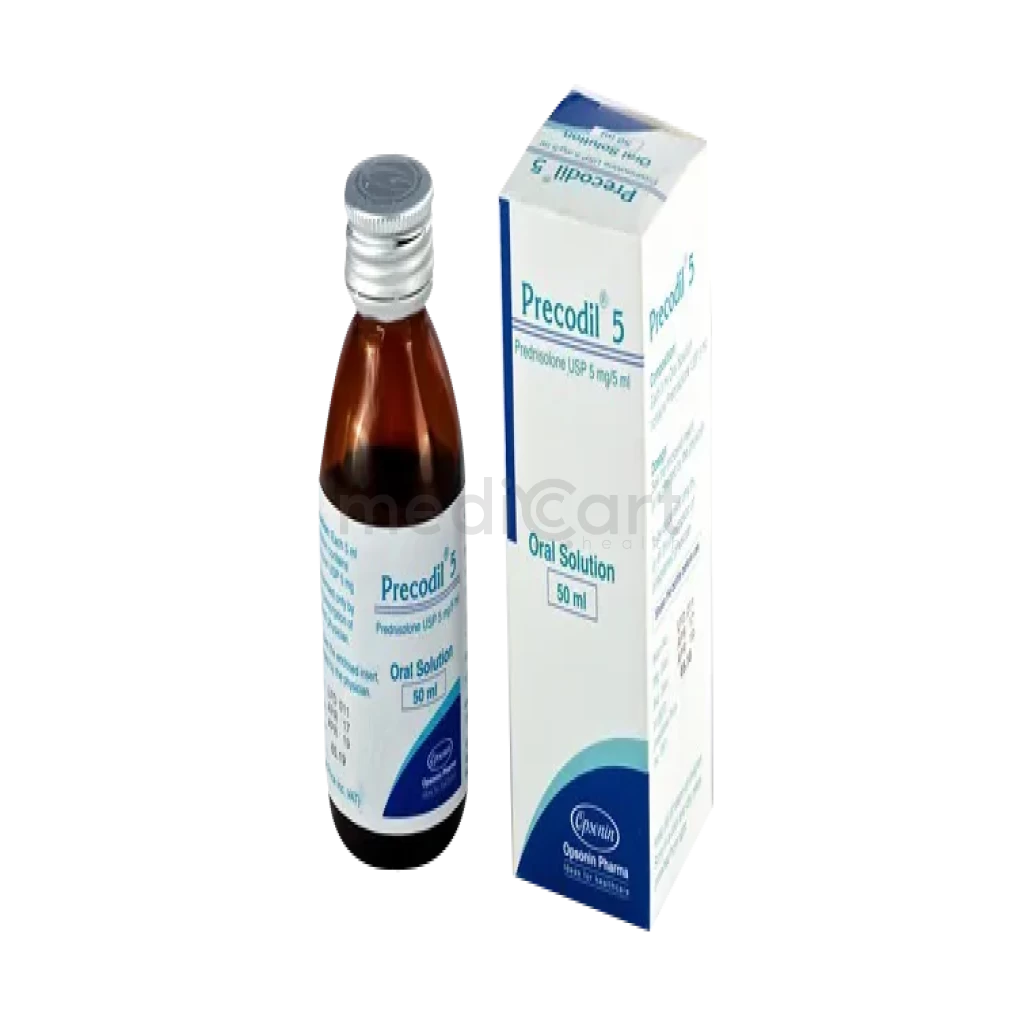

Precodil 50ml - 5mg
Oral Solution* Delivery will be done in Dhaka city only.
Alternative Product
More Information About - Precodil 50ml - 5mg
Description
Generic Name
Prednisolone
Precaution
Patients with hypothyroidism, cirrhosis, ulcerative colitis, CHF, convulsive disorders, thrombophlebitis, peptic ulcer, elderly. DM, hypertension, psychological disturbances, osteoporosis; pregnancy, lactation. Adrenal suppression and infection. May cause irreversible growth retardation, glaucoma, corneal perforation. Lactation: Excreted in breast milk; use caution
Indication
Rheumatoid arthritis, Multiple sclerosis, Allergic and inflammatory disorders, Nephrotic syndrome, Idiopathic thrombocytopenic purpura, Joint inflammations, Moderate to severe asthma, Infantile spasms
Contra Indication
Live vaccines; herpes simplex keratitis, systemic infections.
Dose
N/A
Side Effect
Acne,Adrenal suppression,Delayed wound healing,Diabetes mellitus,GI perforation,Glucose intolerance,Hepatomegaly,Hypokalemic alkalosis,Increased transaminases,Insomnia,Menstrual irregularity,Myopathy,Neuritis,Osteoporosis,Peptic ulcer,Perianal pruritus,Pituitary adrenal axis suppression,Pseudotumor cerebri (on withdrawal),Psychosis,Seizure,Ulcerative esophagitis,Urticaria,Vertigo,Weight gain Potentially Fatal: Acute adrenal insufficiency precipitated by infection, trauma or surgery in patients on long-term therapy or following cessation of such therapy. CV collapse following rapid IV injection.
Pregnancy Category
Name : Not Classified
Description
FDA has not yet classified the drug into a specified pregnancy category.Mode of Action
Prednisolone decreases inflammation by inhibition of migration of polymorphonuclear leukocytes and reversal of increased capillary permeability. It suppresses the immune system by reducing the activity and production of the lymphocytes and eosinophils.
Interaction
Efficacy may be reduced by phenytoin, phenobarb, rifampicin. Corticoids may reduce the effects of diuretics, hypoglycaemics, anticholinesterases, salicylates.
Pregnancy Category Note
Pregnancy Prednisolone shown to be teratogenic in mice when given in doses 1-10 times human dose; dexamethasone, hydrocortisone, and prednisolone were ocularly applied to both eyes of pregnant mice five times per day on days 10 through 13 of gestation; a significant increase in the incidence of cleft palate observed in fetuses of treated mice; there are no adequate well-controlled studies in pregnant women; prednisolone should be used during pregnancy only if potential benefit justifies potential risk to fetus Lactation Not known whether topical ophthalmic administration of corticosteroids could result in sufficient systemic absorption to produce detectable quantities in breast milk; systemically administered corticosteroids appear in human milk and could suppress growth, interfere with endogenous corticosteroid production, or cause other untoward effects Because of potential for serious adverse reactions in nursing infants from prednisolone, a decision should be made whether to discontinue nursing or to discontinue drug, taking into account importance of drug to mother
Adult Dose
Oral Allergic and inflammatory disorders Adult: 5-60 mg daily in 2-4 divided doses. Maintenance: 2.5-15 mg daily. Withdrawal should be gradual after long-term therapy. Poorly controlled, moderate to severe asthma, COPD Adult: Patients with at least 2 exacerbations/yr requiring oral corticosteroids: 40-60 mg daily in 1-2 divided doses; usually given as a short course treatment over 10-14 days until symptom resolution and patient achieves a peak expiratory flow (PEF) of at least 80% of his or her personal best. Rheumatoid arthritis Adult: Initially, 5-7.5 mg daily, adjusted as necessary. Elderly: 5 mg daily. Multiple sclerosis Adult: 200 mg daily for 1 wk followed by 80 mg every other day for 1 mth. Bells Palsy 60 mg PO qDay for 5 days; then taper down by 10 mg daily for 5 days for total duration time of 10 days
Child Dose
Inflammation 0.1-2 mg/kg/day PO in single daily dose or divided q6-12hr; not to exceed 80 mg/day Acute Asthma 1-2 mg/kg/day in single daily dose or divided q12hr for 3-5 days Nephrotic Syndrome First 4 weeks: 60 mg/m²/day or 2 mg/kg/day PO divided q8hr until urine is protein free for 3 consecutive days; not to exceed 28 days; dose not to exceed 80 mg/day Subsequent 4 weeks: 40 mg/m² or 1-1.5 mg/kg PO every other day; not to exceed 80 mg/day Maintenance in frequent relapses: 0.5-1 mg/kg/dose PO every other day for 3-6 months Idiopathic thrombocytopenic purpura Child: 1-10 yr: 1-2 mg/kg daily (max: 14 days) or 4 mg/kg daily (max: 4 days).
Renal Dose
N/A
Administration
Should be taken with food.
Disclaimer
The information provided herein are for informational purposes only and not intended to be a substitute for professional medical advice, diagnosis, or treatment. Please note that this information should not be treated as a replacement for physical medical consultation or advice. Great effort has been placed to provide accurate and comprehensive data. However, Medicart along with its authors and editors make no representations or warranties and specifically disclaim all liability for any medical information provided on the site. The absence of any information and/or warning to any drug shall not be considered and assumed as an implied assurance of the Company.










